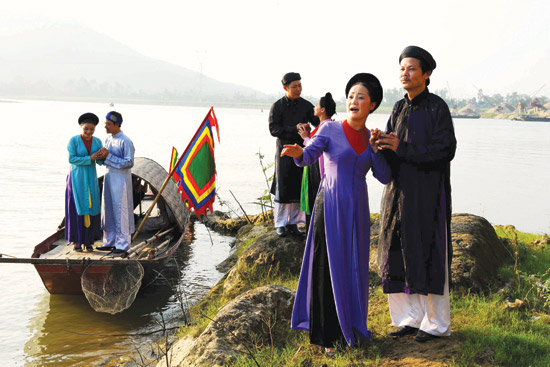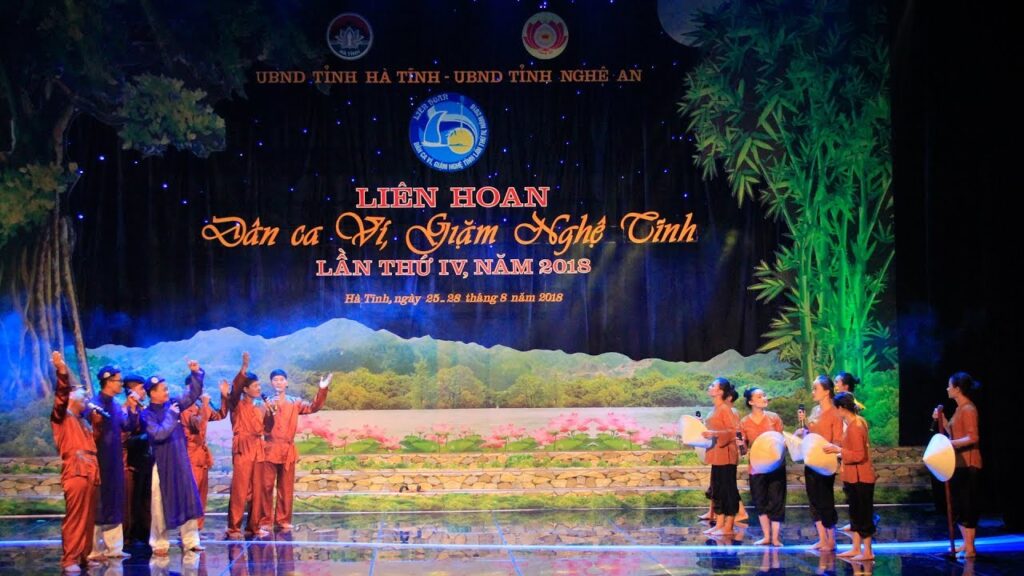
Vi and Giam folk songs of Nghe Tinh hold an important position in the cultural and spiritual lives of the people of Nghe An and Ha Tinh provinces (referred to as Nghe Tinh). This is an art form with lasting vitality, deeply imbued with the soul and character of the people of Nghe An, and is a precious heritage in Vietnam’s cultural treasure.
Introduce
In the cultural treasure of Nghe An, Vi and Giam are two unique folk songs of Nghe An and Ha Tinh provinces with unique features that cannot be confused with folk songs of any region. Born hundreds of years ago, Vi and Giam Nghe – Tinh folk songs originated from working life, so each melody and verse corresponds to each profession. These are two styles of folk singing without musical accompaniment, created by the Nghe An community. The lyrics have diverse content, reflecting all aspects of life. Many songs are deeply educational: respect for parents, loyalty, gratitude, honesty, and contributing to preserving good customs and traditions in social behavior in the village. Vi and Giam folk songs are widely practiced in the Vietnamese community in Nghe An and Ha Tinh provinces. According to inventory results of the Vietnam Institute of Culture and Arts (2013), there are 260 villages, of which 168 villages in Nghe An province and 92 villages in Ha Tinh province have people practicing Vi and Giam folk songs.
History of development
Most folk culture researchers agree that Vi and Giam folk songs, like many other types of folk songs in the Northern Delta, originated from the working and daily lives of the people. The people’s class, therefore, has a long history of formation and development.
Learning about Vietnamese folk songs was only about 2 centuries ago when feudal scholars began to pay attention to compiling a treasure trove of proverbs, folk songs, and national folk songs in the late Le and early Nguyen periods, and the research on them took place even later, so it is very difficult to accurately point out the birth time of Vi and Giam folk songs.
However, through many different sources of documents from scholars, researchers, collectors, and musicians, it can be seen that in the 17th and 18th centuries, Vi and Giam singing was very developed and became a form of performance. Folklore is popular in the Nghe An and Ha Tinh communities, attracting the participation of many different social classes.
The melody Vi of Fabric Ward has been around for hundreds of years, with the participation of workers, Confucian scholars, and teachers.

From the 19th century to the mid-20th century, Vi and Giam folk songs were widely circulated and formed several centers with the active participation of patriotic scholars and intellectuals.
From a form of folk art of working people, along with the shaping and editing of many generations of artisans over time, with the participation and refinement of Confucian scholars, famous scholars, and academicians, Vi and Giam folk songs are increasingly perfected, with tight layouts, delicate sentences, and refined rhymes, to become an attractive art form with high artistic value.
Unique features
Vi and Giam melodies have folk poetic lyrics that are concise, easy to memorize, easy to remember, and easy to sing, so they are always transmitted, inherited, and created.
This type of folk song also has content that reflects society and history. Expresses thoughts, feelings, love for life, love for homeland, country, and love for couples; Teachings and philosophies that value meaning and love and are imbued with the humanity of the Vietnamese people.
Experts estimate that there are about 15 Vi melodies and 8 Giam melodies, named according to the context of life, work, and profession.
Outstanding value

Vi and Giam folk songs are closely associated with the life and customs of Nghe Tinh community, have strong vitality, and are always transmitted, preserved, and promoted in contemporary life. This is a type of art that can express the thoughts and feelings of Nghe Tinh people, and at the same time realistically reflect all changes in social life.
Besides, Vi, Giam folk songs also contribute to educating traditional moral values such as filial piety to parents, marital fidelity, and how to behave between people; Calling for the fight against oppression and injustice in society. Participating in Vi and Giam singing is an opportunity to strengthen community cohesion.
Vi and Giam folk songs are an “open” space for everyone who loves singing, regardless of age, gender, profession, or religion. Singing events ensure equal rights and mutual respect between communities, groups, and individuals, contributing to the sustainable development of society. Vi and Giam folk songs are also a source of inspiration and material for contemporary artists to compose many musical and theatrical works with folk influences, contributing to enriching the cultural and spiritual lives of people.
Conclusion
Vi and Giam folk songs of Nghe Tinh were honored by UNESCO as an Intangible Cultural Heritage of Humanity in November 2014.
Cultural heritage in general is always the content that attracts tourists. Cultural heritage tourism can promote and turn cultural potential into a driving force for economic development. Through tourism activities, cultural heritage is widely introduced around the world. The close and synchronous combination of national target programs on culture and tourism, including Vi and Giam folk songs in tourism activities, is a feasible and necessary direction today. Therefore, both preserve and promote heritage values while achieving economic goals and developing tourism. Since Vi and Giam folk songs were recognized as an intangible cultural heritage of humanity, there have been many activities to encourage and incorporate this type of folk song into tourism development.
Get an opportunity to visit Intangible World Cultural Heritage in Vietnam through Vietnam E-Visa!